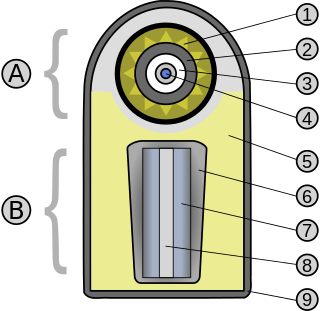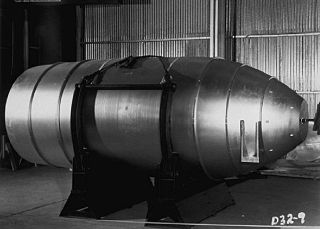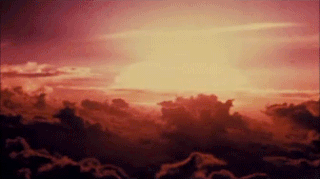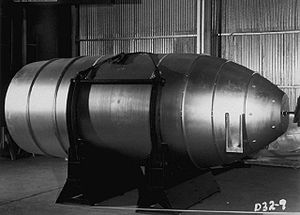
Nuclear Weapons Design are physical, chemical, and engineering arrangements that cause the physics package of a nuclear weapon to detonate. There are three existing basic design types:
- Pure fission weapons are the simplest, least technically demanding, were the first nuclear weapons built, and so far the only type ever used in warfare, by the United States on Japan in World War II.
- Boosted fission weapons increase yield beyond that of the implosion design, by using small quantities of fusion fuel to enhance the fission chain reaction. Boosting can more than double the weapon's fission energy yield.
- Staged thermonuclear weapons are arrangements of two or more "stages", most usually two. The first stage is normally a boosted fission weapon as above. Its detonation causes it to shine intensely with X-rays, which illuminate and implode the second stage filled with a large quantity of fusion fuel. This sets in motion a sequence of events which results in a thermonuclear, or fusion, burn. This process affords potential yields up to hundreds of times those of fission weapons.

Operation Ivy was the eighth series of American nuclear tests, coming after Tumbler-Snapper and before Upshot–Knothole. The two explosions were staged in late 1952 at Enewetak Atoll in the Pacific Proving Ground in the Marshall Islands.

Operation Castle was a United States series of high-yield (high-energy) nuclear tests by Joint Task Force 7 (JTF-7) at Bikini Atoll beginning in March 1954. It followed Operation Upshot–Knothole and preceded Operation Teapot.

Operation Greenhouse was the fifth American nuclear test series, the second conducted in 1951 and the first to test principles that would lead to developing thermonuclear weapons. Conducted at the new Pacific Proving Ground, on islands of the Enewetak Atoll, it mounted the devices on large steel towers to simulate air bursts. This series of nuclear weapons tests was preceded by Operation Ranger and succeeded by Operation Buster-Jangle.

Operation Upshot–Knothole was a series of eleven nuclear test shots conducted in 1953 at the Nevada Test Site. It followed Operation Ivy and preceded Operation Castle.

Castle Bravo was the first in a series of high-yield thermonuclear weapon design tests conducted by the United States at Bikini Atoll, Marshall Islands, as part of Operation Castle. Detonated on 1 March 1954, the device remains the most powerful nuclear device ever detonated by the United States and the first lithium deuteride-fueled thermonuclear weapon tested using the Teller-Ulam design. Castle Bravo's yield was 15 megatons of TNT [Mt] (63 PJ), 2.5 times the predicted 6 Mt (25 PJ), due to unforeseen additional reactions involving lithium-7, which led to radioactive contamination in the surrounding area.

Ivy Mike was the codename given to the first full-scale test of a thermonuclear device, in which a significant fraction of the explosive yield comes from nuclear fusion. Ivy Mike was detonated on November 1, 1952, by the United States on the island of Elugelab in Enewetak Atoll, in the now independent island nation of the Marshall Islands, as part of Operation Ivy. It was the first full test of the Teller–Ulam design, a staged fusion device.

Elugelab, or Elugelap, was an island, part of the Enewetak Atoll in the Marshall Islands. It was destroyed in the world's first full-scale thermonuclear explosion, the Mike shot of Operation Ivy, on November 1, 1952. Prior to being destroyed, the island was described as "just another small naked island of the atoll".
RDS-6s was the first Soviet attempted test of a thermonuclear weapon that occurred on August 12, 1953, that detonated with a force equivalent to 400 kilotons of TNT.
RDS-37 was the Soviet Union's first two-stage hydrogen bomb, first tested on 22 November 1955. The weapon had a nominal yield of approximately 3 megatons. It was scaled down to 1.6 megatons for the live test.

Castle Yankee was the code name given to one of the tests in the Operation Castle series of American tests of thermonuclear bombs. It was originally intended as a test of a TX-16/EC-16 Jughead bomb, but the design became obsolete after the Castle Bravo test was successful. The test device was replaced with a TX-24/EC-24 Runt II bomb which was detonated on May 5, 1954, at Bikini Atoll. It released energy equivalent to 13.5 megatons of TNT, the second-largest yield ever in a U.S. fusion weapon test.

Castle Romeo was the code name given to one of the tests in the Operation Castle series of U.S. nuclear tests. It was the first test of the TX-17 thermonuclear weapon, the first deployed thermonuclear bomb.

A thermonuclear weapon, fusion weapon or hydrogen bomb (H bomb) is a second-generation nuclear weapon design. Its greater sophistication affords it vastly greater destructive power than first-generation nuclear bombs, a more compact size, a lower mass, or a combination of these benefits. Characteristics of nuclear fusion reactions make possible the use of non-fissile depleted uranium as the weapon's main fuel, thus allowing more efficient use of scarce fissile material such as uranium-235 or plutonium-239. The first full-scale thermonuclear test was carried out by the United States in 1952, and the concept has since been employed by most of the world's nuclear powers in the design of their weapons.

The Teller–Ulam design is a technical concept behind modern thermonuclear weapons, also known as hydrogen bombs. The design – the details of which are military secrets and known to only a handful of major nations – is believed to be used in virtually all modern nuclear weapons that make up the arsenals of the major nuclear powers.

The Mark 24 nuclear bomb was an American thermonuclear bomb design, based on the third American thermonuclear bomb test, Castle Yankee. The Mark 24 bomb was tied as the largest weight and size nuclear bomb ever deployed by the United States, with the same size and weight as the Mark 17 nuclear bomb which used a very similar design concept but unenriched lithium.

The Mark 14 nuclear bomb was a 1950s strategic thermonuclear weapon, the first deployed solid-fuel hydrogen bomb. It was an experimental design, and only five units were produced in early 1954. It was tested in April 1954 during the Castle Union nuclear test and had a yield of 6.9 Mt. The bomb is often listed as the TX-14 or EC-14. It has also been referred to as the "Alarm Clock" device though it has nothing to do with the design by the same name proposed earlier by Edward Teller and known as the Sloika in the Soviet Union.
The Mark 16 nuclear bomb was a large American thermonuclear bomb, based on the design of the Ivy Mike, the first thermonuclear device ever test fired. The Mark 16 is more properly designated TX-16/EC-16 as it only existed in Experimental/Emergency Capability (EC) versions.

Operation Redwing was a United States series of 17 nuclear test detonations from May to July 1956. They were conducted at Bikini and Enewetak atolls by Joint Task Force 7 (JTF7). The entire operation followed Project 56 and preceded Project 57. The primary intention was to test new, second-generation thermonuclear weapons. Also tested were fission devices intended to be used as primaries for thermonuclear weapons, and small tactical weapons for air defense. Redwing demonstrated the first United States airdrop of a deliverable hydrogen bomb during test Cherokee. Because the yields for many tests at Operation Castle in 1954 were dramatically higher than predictions, Redwing was conducted using an "energy budget": There were limits to the total amount of energy released, and the amount of fission yield was also strictly controlled. Fission, primarily "fast" fission of the natural uranium tamper surrounding the fusion capsule, greatly increases the yield of thermonuclear devices, and constitutes the great majority of the fallout, as nuclear fusion is a relatively clean reaction.

The Mk 36 was a heavy high-yield nuclear bomb developed by the United States during the 1950s. It was a thermonuclear, using a multi-stage fusion secondary system to generate yields up to about 10 megatons TNT equivalent.
Sundial was the codename of one of two massive nuclear bombs planned for testing by the University of California Radiation Laboratory, Livermore Branch as part of a classified American weapons project in the early 1950s. Announced by Edward Teller at a meeting of the General Advisory Committee of the Atomic Energy Commission, it was intended to have a yield of 10 gigatons of TNT, while its counterpart, Gnomon, was intended to have a yield of 1 gigaton.














